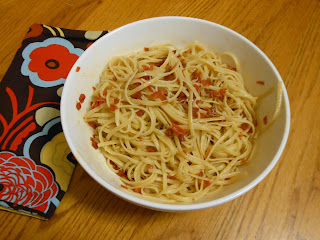 Earlier in the month, I received the name of the pen pal I would be mailing goodies to, while somewhere in the foodie universe someone had gotten my name (kind of like a Secret Santa in April!) I couldn’t wait to go shopping! A day after I sent out my box, one arrived in the mail addressed to me.
Earlier in the month, I received the name of the pen pal I would be mailing goodies to, while somewhere in the foodie universe someone had gotten my name (kind of like a Secret Santa in April!) I couldn’t wait to go shopping! A day after I sent out my box, one arrived in the mail addressed to me.A few days before our goodie box arrived, I received and email from my Foodie Penpal Kristina letting me know the box was on the way and an added bonus – a guest blog post explaining one the items she had included in the box. Not being one for delayed gratification, it was with great torture that I waited until the box arrived to read the post she had sent.
 It is such a beautiful story and one very similar to ours. Kristina’s writing style is akin to mine as well. I must admit I got a little misty eyed reading the post (which I will share tomorrow for your reading pleasure!).
It is such a beautiful story and one very similar to ours. Kristina’s writing style is akin to mine as well. I must admit I got a little misty eyed reading the post (which I will share tomorrow for your reading pleasure!). Oh! I suppose you would like to know what Kristina sent us… Without further ado, our box included a bottle of honey from Jarek Apiary for which Sonny called dibs. He uses honey on everything, especially his toasted waffle each morning for breakfast because he doesn't prefer maple syrup.
The next item was Dr. Gonzo’s “Garlicmash No. 4;” a pulpy concoction of pureed garlic, olive oil, cayenne pepper, salt and sugar. We can't wait to dive into that jar! We use copious amounts of garlic in all of our food and this will certainly be a huge hit.
 It was truly as though Kristina had a crystal ball. All the items she sent are household favorites including her homemade specialty of spicy caramel popcorn. All four of us adore caramel corn in any form (kettle corn, Fiddle Faddle, Cracker Jack), so as you can well imagine, the two Ziploc bags-full disappeared in record time.
It was truly as though Kristina had a crystal ball. All the items she sent are household favorites including her homemade specialty of spicy caramel popcorn. All four of us adore caramel corn in any form (kettle corn, Fiddle Faddle, Cracker Jack), so as you can well imagine, the two Ziploc bags-full disappeared in record time. And the pièce de résistance, a four-pack of squid ink. Yes, squid ink! Now I know what you are thinking; why would anyone be so excited about receiving squid ink in the mail?
When Dom and I were dating, we would go to this quaint, romantic little Italian restaurant that has since gone out of business called Lindy's Café in Atlanta’s Peachtree Hills neighborhood. They made squid ink pasta with calamari that was his favorite dish. We have always wanted to try to make it at home. As most of our readers know, we frequently make our own pasta and have always wanted to try to make fresh squid ink pasta. We have been searching for squid ink in a package designed for home use, but have only seen it in expensive, industrial-sized amounts. We are thrilled to have some to try and to know where we can get more!! We will definitely share the results when we have the opportunity to try it out.
Do you want to be a Foodie Penpal? You don't even have to be a blogger - just someone who loves food and trying new treats! Visit Lindsay’s blog for program details and to sign-up. And stay-tuned for next month’s Reveal Day!













